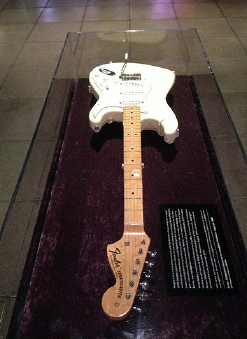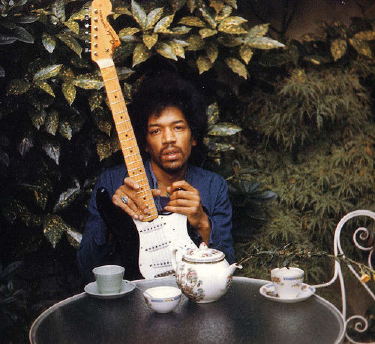The Black Start
At the Hendrix museum in Seattle, you can see Jimi’s famous white Stratocaster, the guitar he played at Woodstock. It’s in a temperature and humidity controlled case, having been purchased for the Experience Music Project by Microsoft co-founder Paul Allen for an undisclosed amount. Around $2 million, the Internet rumors say.
How much Hendrix valued the guitar is another matter. It was clearly important to him—but it’s also true that Jimi lived in the moment, and his guitars came and went. According to drummer Mitch Mitchell, Hendrix rather casually gave him the White Strat after what would turn out to be his last live performance at the Isle of Fehmarn in September 1970.
Years later, when Mitchell auctioned the guitar at Sotheby’s he offered this description:
“Jimi Hendrix was always breaking his guitars and getting new ones but this particular white Fender Stratocaster serial number 240981 was a particular favourite of his. He used it at the Woodstock Festival in August 1969 playing the now famous “Star Spangled Banner” on this guitar. I had given him a drum kit as a present some time before and I said to him ‘I’ll have that guitar before you break it up’ (I do not think that he would in fact have broken this particular guitar). He said, as was his way ‘You got it’ and he then gave me the guitar. In retrospect I think it was by way of a gift as my daughter had just been born a few days previously. I think this was one of the last gigs ever played by us.”

There was also a black Stratocaster, whereabouts currently unknown, or at least unproven. If the White Strat is one of the most expensive collectable guitars in the world, the Black Strat (called the Black Beauty by most Hendrix gearheads) is one of the most mythologized.
We have the word of Monika Dannemann—who was or wasn't with Jimi when he died and who was or wasn't Jimi's girlfriend, depending on which books you read and whom you believe—that the Black Strat was even more precious to Jimi than the White Strat. We also have Charles Cross’ exhaustively researched Hendrix biography, Room Full of Mirrors, in which Monika does not seem to be truthful about even the most basic facts of Jimi’s death and their relationship. That fact that she ended up with the guitar, at least for a while, might conceivably have played a role in what she said about it, and what she said Jimi said.
Still, one thing about Monika is certain: she took the last photos of Jimi, sitting in a London garden the day before he died. In most of the shots, he’s holding the Black Strat. Proving not very much, but starting the legend. WIthout a doubt, it's the rarest of rare guitars, a gearhead's Holy Grail, and that makes it practically priceless. And yet, if Jimi's looking down at us, I have to wonder if he might be laughing and telling us it's just a guitar.
We can't ask Jimi, of course, and I don't know how to ask the axis. So we turn to the Internet instead, which provides enough Hendrix/Strat rabbit holes to keep entire data centers buzzing until a golden wing ship passes our way and just keeps on going. It was his favorite guitar, it was just one of many, Scorpion's guitarist Uli Jon Roth has it, Janie Hendrix has it, Jimi died because of the guitar, his manager murdered him, the cursed guitar led to Monika’s suicide, Monika was murdered…stock up on supplies, head to your wi-fi enabled bomb shelter and spend a couple of years tracking down the threads. You'll have fun.

Jimi with the Black Strat. Image via Metro Amp message board: http://forum.metroamp.com/viewtopic.php?f=33&t=33486
If you do, you’ll see my footprints on a lot of those trails, because the black Fender Stratocaster serial number 222625 fascinates me. In the book I’m currently working on, Dogs Run Free, a guitar player I call Ray Raims is searching for the Strat. His brother gets his hands on it—but then the brother and guitar disappear.
It’s a decent plot device—I hope—but the guitar is also a marker for the questions of value and worth that are behind so many issues that mess with us today. The monetization of everything. The elevation of celebrity over talent. Wall Street greed. Occupy. Take, for instance, those highly valued credit default swaps that turned toxic and wrecked our economy—were the bankers who sold them any more honest about their true value than Monika Dannemann?
The Hendrix guitar isn’t the main story in Dogs Run Free, but I keep coming back to it partly because it’s out there somewhere, in some pawnshop maybe, or more likely some vault, along with all these questions about money and the way we live.
As Dylan wrote and Jimi sang, sort of, none of us along the line seem to know what any of it is worth.
________________________
I'll be reading a little of Dogs Run Free at LitHop on October 2. If you're in Portland, stop in at Bar of the Gods on SE Hawthorne. I'd like to see you. LitHop PDX starts at 7:00 and the lineup of readers is amazing.
 Subscribe to the RSS feed
Subscribe to the RSS feed